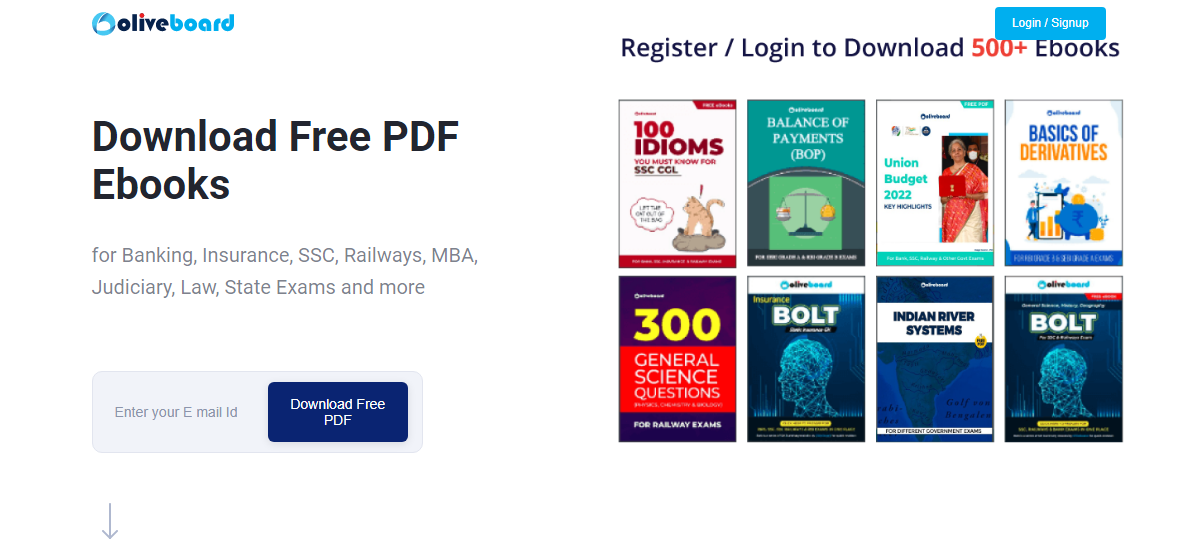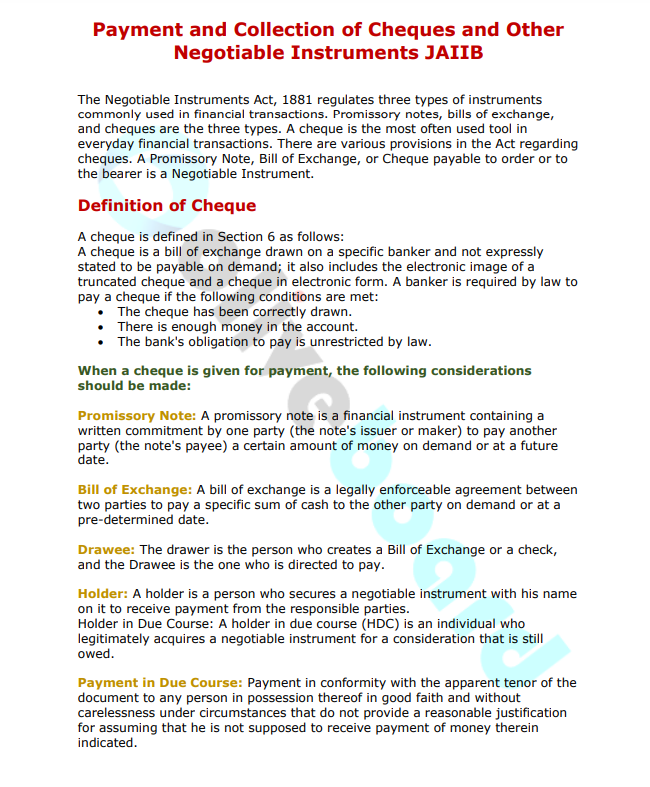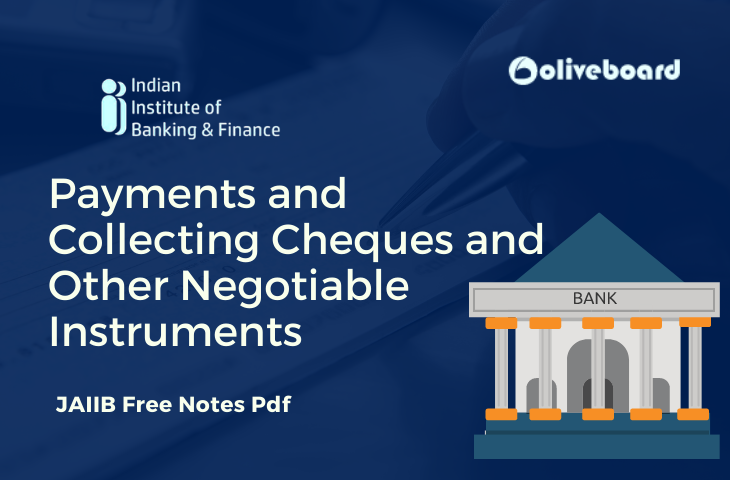The Negotiable Instruments Act, 1881 regulates three types of instruments commonly used in financial transactions. Promissory notes, bills of exchange, and cheques are the three types. A cheque is the most often used tool in everyday financial transactions. There are various provisions in the Act regarding cheques. A Promissory Note, Bill of Exchange, or Cheque payable to order or to the bearer is a Negotiable Instrument. One of the most crucial things that aspirants of the JAIIB exam should know is the payment and collection of cheques and other negotiable instruments. The JAIIB exam is held twice a year. In this blog, we will be discussing the Payment and Collection of Cheques and other negotiable instruments
Download Payment and Collection of Cheques E-Book Here
How to Download Payment and Collection of Cheques for JAIIB E-book?
Step 1: Click on the download link. You will be redirected to Oliveboard’s FREE E-Books Page.

Step 2: Create a free Oliveboard account or login using your existing Oliveboard account details
Step 3: Download the book by clicking on the link presented on the page.
Introduction
The Negotiable Instruments Act, 1881 regulates three types of instruments commonly used in financial transactions. Promissory notes, bills of exchange, and cheques are the three types. A cheque is the most often used tool in everyday financial transactions. There are various provisions in the Act regarding cheques. A Promissory Note, Bill of Exchange, or Cheque payable to order or to the bearer is a Negotiable Instrument.
Definition of Cheque
A cheque is defined in Section 6 as follows:
A cheque is a bill of exchange drawn on a specific banker and not expressly stated to be payable on demand; it also includes the electronic image of a truncated cheque and a cheque in electronic form. A banker is required by law to pay a cheque if the following conditions are met:
- The cheque has been correctly drawn.
- There is enough money in the account.
- The bank’s obligation to pay is unrestricted by law.
Cheque Considerations
When a cheque is given for payment, the following considerations should be made:
- Promissory Note: A promissory note is a financial instrument containing a written commitment by one party (the note’s issuer or maker) to pay another party (the note’s payee) a certain amount of money on demand or at a future date.
- Bill of Exchange: A bill of exchange is a legally enforceable agreement between two parties to pay a specific sum of cash to the other party on demand or at a pre-determined date.
- Drawee: The drawer is the person who creates a Bill of Exchange or a check, and the Drawee is the one who is directed to pay.
- Holder: A holder is a person who secures a negotiable instrument with his name on it to receive payment from the responsible parties.
- Holder in Due Course: A holder in due course (HDC) is an individual who legitimately acquires a negotiable instrument for a consideration that is still owed.
- Payment in Due Course: Payment in conformity with the apparent tenor of the document to any person in possession thereof in good faith and without carelessness under circumstances that do not provide a reasonable justification for assuming that he is not supposed to receive payment of money therein indicated.
- Negotiation: It depends on the type of negotiation in question. When you negotiate a cheque, you are discussing a negotiable instrument.
- Endorsement: An endorsement is the act of a holder of a negotiable document signing his or her name on the back of that instrument, therefore transferring title or ownership. An endorsement can be given to another person or legal body. An endorsement transfers property to the other individual or legal body. The individual who receives the endorsement is known as the endorsee. The endorser is the individual who makes the endorsement.
Crossing of Cheques
The act of crossing a cheque entails ordering the banker to pay the stated money solely through the banker, i.e. the amount on the cheque must be placed directly into the payee’s bank account.
Types of Crossing a cheque:
General Crossing:
When two transverse parallel lines are drawn across the face of a cheque, the words & Co. are written between the two lines, with or without the words not negotiable. A general crossing occurs when a check is crossed in this manner.
Special Crossing:
A cheque with the banker’s name printed across the face between the two transverse parallel lines, with or without the statement ‘not negotiable’. Special crossings are the name for this sort of crossing. In a particular crossing, the paying banker will only pay the cash to the banker whose name appears on the check or his agent. As a result, the check will only be honored if the bank has indicated the same in the crossing orders.
Take a peek at the Payment and Collection of Cheques E-book

Conclusion
In this blog, we discussed Paying and Collecting Cheques for the JAIIB Exam. We hope that the information provided will help candidates prepare for the exam. Keep following Oliveboard for more updates. To stay updated, follow Oliveboard on Facebook and Telegram.
JAIIB Study Material Compilation
Also Read:
- 5-Important Tips To Crack JAIIB Exams| Check Here (oliveboard.in)
- JAIIB Frequently Asked Questions- 2022| Check Here (oliveboard.in)
- JAIIB Genius | JAIIB Weekly Quiz PDF – JAIIB Questions PDF (oliveboard.in)
- JAIIB Full Form – Junior Associate of the Indian Institute of Bankers (oliveboard.in)
- JAIIB and CAIIB Books- Exams Syllabus, Books, and more (oliveboard.in)
Also Check:
- JAIIB 2022 Exam -Notification Released (oliveboard.in)
- JAIIB Notification 2022 – Notification PDF, Eligibility, (oliveboard.in)
- JAIIB Apply Online – Application Form 2022, Fees, Instru (oliveboard.in)
- JAIIB Eligibility – Age, Degree, Nationality, Members (oliveboard.in)
- JAIIB Syllabus – Complete List of Papers, Modules (oliveboard.in)
- JAIIB Exam Pattern 2022 – Details of Pattern, Marking (oliveboard.in)
- JAIIB Admit Card November 2022 – Steps and Direct Download (oliveboard.in)
- JAIIB 2022 Cut Offs – Check JAIIB Minimum Cut Off (oliveboard.in)

Hello there! I’m a dedicated Government Job aspirant turned passionate writer & content marketer. My blogs are a one-stop destination for accurate and comprehensive information on exams like Regulatory Bodies, Banking, SSC, State PSCs, and more. I’m on a mission to provide you with all the details you need, conveniently in one place. When I’m not writing and marketing, you’ll find me happily experimenting in the kitchen, cooking up delightful treats. Join me on this journey of knowledge and flavors!
